#vought aircraft company
Explore tagged Tumblr posts
Text

A wing. And a gun. And an engine by Nash! Nash-Kelvinator Corporation ad - 1942.
#vintage illustration#vintage advertising#american industry#life during wartime#ww2#wwii#wwii era#ww2 era#the 40s#the 1940s#war production#military industrial complex#war supplies#world war ii#world war two#world war 2#nash-kelvinator#nash-kelvinator corporation#nash#u.s. military#u.s. navy#kelvinator#military aircraft#vought f4u corsair#vought f4u#vought aircraft company
34 notes
·
View notes
Text

axis-and-allies-paintworks.com
Phantom II / USAAF / USN Library / Forums
Text By Greg Goebal as always thanks. * The McDonnell Aircraft Company was founded in 1939 by James S. McDonnell. The company survived the war years through subcontract work for major aircraft manufacturers such as Grumman and Vought.
10 notes
·
View notes
Text
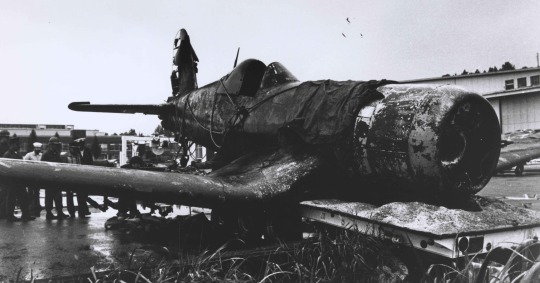
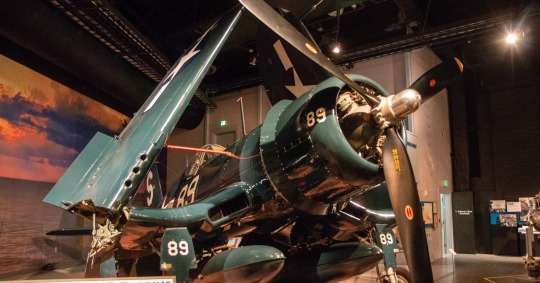
If you ever want to “well, actually” the most knowledgeable AvGeek in your life, tell them this plane isn’t a Vought F4U Corsair. Though it’s the same as the iconic World War II airplane, our airframe is special because it was manufactured by Goodyear. Like many companies during the war, the tire maker pivoted to make things for the war effort, including this Goodyear FG-1D Corsair. The aircraft was designed by Queen Anne High School and University of Washington graduate Rex Beisel
This specific airframe is a memorable piece of Seattle history. It was stationed at Naval Station Puget Sound at Sand Point, just north of the University of Washington. In 1950, the plane collided with another aircraft during training. The pilots of both planes were fine, but the aircraft sank into Lake Washington. It sat at the bottom of the lake for decades until it was recovered and restored for display here at the Museum. Here’s a photo of the plane shortly after it was fished up from the water. Next to it is a picture of the aircraft today. What a difference! This restoration is a testament to the dedication of the volunteers, staff and donors who made it happen. Looking at it in the Museum, you’d never know it was keeping fish company for over 30 years.
source - https://www.facebook.com/museumofflight
8 notes
·
View notes
Text
The one thing that puzzles me about THE BOYS is the name of the evil corporation. "Vought" was an actual company, an aircraft and missile manufacturer and military contractor named for founder Chance M. Vought, which was eventually absorbed into a conglomerate called Ling-Temco-Vought (LTV). LTV went bankrupt and was dissolved in 2001, but the Vought trademark seems to have ended up in limbo; according to the USPTO database, it was finally voluntarily canceled by the company that ended up owning it, but not until 2014, after THE BOYS comic ended.
While comic book writers can sometimes get away with this kind of thing because no one other than other comics people care enough to pursue it, it's the kind of thing that tends to make the legal clearances departments of TV and film studios very, very nervous, for obvious reasons: If you present a fictional corporation founded by Nazis doing various evil shit and give it the trademarked name of an actual company — and a U.S. defense contractor, at that — you'd better be damned sure the mark is really and truly dead or you're gonna get sued.
#comics#teevee#the boys#garth ennis#darick robertson#because ennis is a ww2 nerd i am 100 percent sure he was aware that vought was a real company#vought#ling temco vought#even in comics#this is why you end up with fictionalized names like “MacDougals” or “Bloomingcrombie”
1 note
·
View note
Text
Vought aircraft Company management system AI

Texas Instruments Compact Computer 40
198 notes
·
View notes
Text
Here is how they feel about you Carolinas and Texas where I used to work.
Mentioned Vought aircraft company. Mentioned chilli's and 6 flag. Also mentioned my kids song to play and they would be really done last night.
0 notes
Link
BIS Research has worked on numerous market studies featuring the evolution of aircraft and the factors determining the growth of this industry.
Get Aircrafts Market Reports List: https://bisresearch.com/industry-verticals/aircrafts
#aircraft market#aircraft industry#rolls royce aerospace#airplane manufacturers#aviation companies#aviation industry corporation of china#helicopter manufacturers#aviation business#aircraft engine manufacturers#jet engine manufacturers#airplane engine manufacturers#aircraft manufacturing companies#airbus stock market#electric aviation#vought aircraft#airline manufacturers#aviation mro#electric aviation group#military aircraft manufacturers#military drone manufacturers#airplane manufacturing companies#aircraft manufacturing#airbus manufacturing#aerospace parts#airbus industries#aircraft construction#vought industries#business jet market
0 notes
Text
Ghost Blimp: The Mystery and Missing on the L-8
On Sunday, August 16th 1942 Richard L. Johnston was going about his business. He had just finished waxing his car in Dale City, California when he looked up and saw something huge creeping out of the sky and towards his house. Suddenly it hit a utility pole, electrical wires broke sending sparks cascading down to the street, and Johnson ran into the house to protect his mother. When he came back outside there was a large group of people in the street including Fire Deputy Marshal Sean Wood and Johnston’s next door neighbor, volunteer fireman William Morris. Johnston’s car was completely hidden under a massive fold of what looked like canvas. When Johnston woke up that morning he probably didn’t expect that a blimp would land on his car that day. And yet, moments later the scene became even more bizarre.
In August 1942 the United States Navy was on high alert. Within nine months after entering World War II Japanese submarines sunk at least six Allied ships off the American west coast and shelled one of California’s largest oil drilling facilities. The fear of another attack on American soil was high and in order to keep an eye on the sea along the west coast the Navy took to the air, deploying blimps to cruise over the ocean and watch for any suspicious activity.
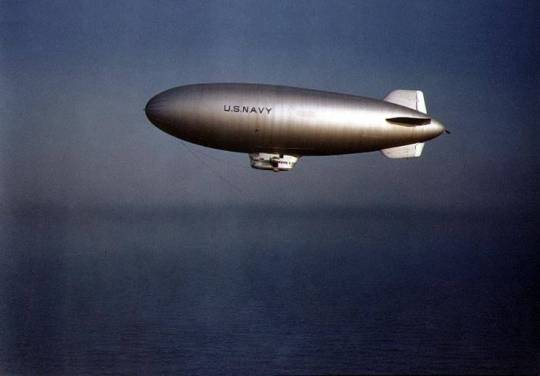
World War II Navy blimp. Image via Wikimedia Commons.
The blimp that landed on Johnson’s car was the L-8 airship, acquired by the Navy from the Goodyear company and commissioned on March 5, 1942. It was an excellent machine, completing over 1,000 trips and never requiring any work beyond routine maintenance. The two-man crew tasked with piloting the airship had records as impeccable as the craft itself. Lieutenant Ernest Dewitt Cody was a 1938 graduate of Annapolis and although he was only twenty-seven years old he was highly regarded with his commanding officer describing him as “one of the most capable pilots and one of the most able officers” under his command. Cody was relatively new to flying LTA (lighter-than-air) airships, but in April 1942 he proved his ability when he flew the L-8 to deliver cargo to the USS Hornet before the ship departed for Doolittle’s Raid over Tokyo. It was that trip that earned him his promotion to Lieutenant in June 1942. Ensign Charles Ellis Adams was eleven years older than Cody and had twenty years of experience flying LTA airships, but only earned his commission the day before their flight together making his trip with Cody his first flight as an officer.

Lieutenant Ernest Dewitt Cody and Ensign Charles Ellis Adams.
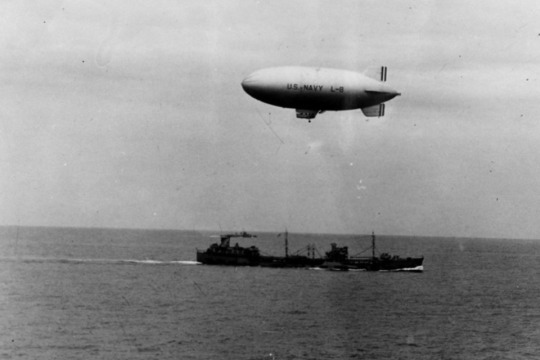
The L-8 delivering cargo to the USS Hornet. Image via National Archives.
Their task together was a routine anti-submarine mission, fly out from Treasure Island, patrol a fifty-mile radius of San Francisco, then head to the Farallon Islands before heading back to Treasure Island. When they left Treasure Island at 6:03am there was approximately five miles of visibility with the Golden Gate Bridge off in the distance. At 7:38am Cody radioed Moffett Field and reported their location as being four miles east of the Farallon Islands. Four minutes later Moffett Field received a second message from Cody, “Am investigating suspicious oil slick—stand by.” Since an oil slick could indicate an enemy submarine below the waves it was not unusual for the airship to investigate the scene. As the L-8 descended closer to the sea its movements were seen by a fishing boat, the Daisy Gray, and a Liberty cargo ship, Albert Gallatin. Apprehensive about seeing the Navy airship creep closer to the surface of the water and then set off two flares, the ship crews pulled in their nets, manned their guns, and nervously waited to see what happened next. But, as they watched the L-8 nothing out of the ordinary happened. The blimp circled for about an hour and crews from both ships could see two men in the gondola. At approximately 9am the blimp again rose into the air and restarted its route back toward San Francisco. Everything appeared normal to the ships and spectators below, but personnel at Moffett Field were getting nervous, they had not heard a word from the L-8 since 7:42am and were not able to reestablish any communication. Two Vought OS2U Kingfisher floatplanes were sent to look for the blimp and other aircraft were asked to keep their eyes open.
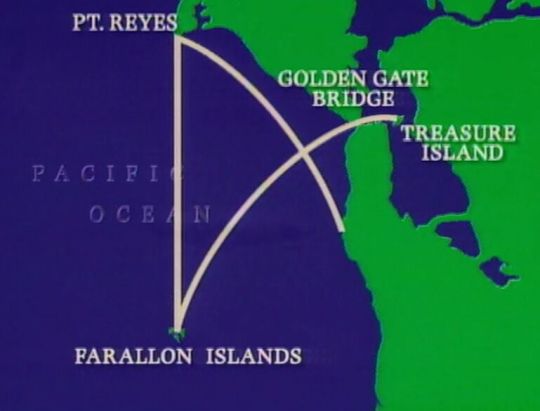
The intended flight path of the L-8 aircraft. Image via unsolvedmysteries.fandom.com.
At approximately 10:49am a series of blimp sightings began to roll in. A Pan American Clipper pilot reported seeing the blimp over the Golden Gate Bridge, then at 11am one of the Kingfishers spotted the L-8 three miles west of Salada Beach at approximately 2,000 feet. Although a height of 2,000 feet would typically be avoided by an airship for safety reasons, there was no indication of the ship being out of control or in danger and it began to descend. The next plane to spot the blimp, an Army P-38 pilot, also saw no indication that the airship or its crew was in any distress when it was seen near Mile Rock, seemingly on its way back to Treasure Island. Within minutes an off-duty seaman named Richard Quam saw the L-8 as he was driving along the highway between San Mateo and San Francisco and he decided to take a picture of the sight. He may have been the first person to capture that something was amiss, the blimp was now noticeably bending in the middle.
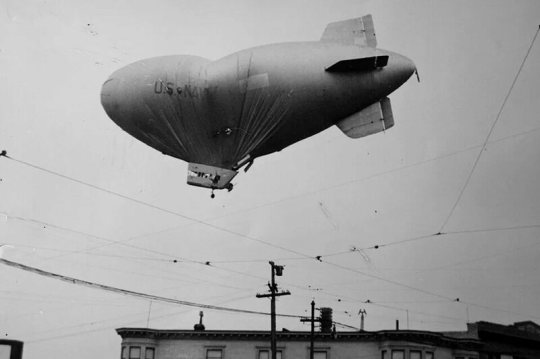
The L-8 airship visible sagging as it flew over Daly City. Image via National Archives.
Things began to happen quickly. At approximately 11:15am the L-8 was seen approaching the shore of Ocean Beach in San Francisco but its motors were now silent and there was noticeable sagging. It touched down on the beach for a moment but kept moving until it hit the side of a hill, knocking off one of its 325lb depth chargers. Now carrying 300lbs less, the airship again rose, clearing the hill, and moving further inland. Thousands of people now watched as the L-8 staggered overhead obviously in peril. But, according to witnesses, the ship was not unmanned, in a later interview seventeen-year-old C.E. Taylor told reporters that as the blimp descended he was watching the cabin through his binoculars and that two men were clearly visible inside the entire time.
Finally, at 11:30am the blimp came to a clumsy rest on top of Richard Johnston’s freshly waxed car. Sirens blared and firemen surrounded the blimp, slashing it open in an attempt to save Cody and Adams inside. But, when the rescuers got to the gondola they found a scene that made no sense. The door was open, the microphone for communication was hanging from the doorway, a hat was resting on the controls, the life raft and all parachutes were still in place, but Cody and Adams were nowhere to be found.
Once the initial shock of the crash wore off a feeling of worry began to quickly take over. The L-8 was traveling an extremely visible route and was tracked and seen by hundreds of people and ships, with many reporting the same as young C. E. Taylor, that the men were visible inside the cabin. The Navy immediately launched a search for Cody and Adams and the craft was inspected for any clues to solve the disappearance. The engines were in perfect running order, the ignition switches were on, and there was four hours of fuel left. The only thing that was unusual on board was that the blimp's batteries were drained and part of the fuel supply had been dumped out with no obvious explanation why.
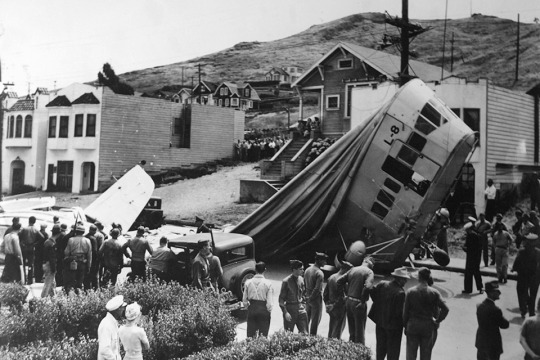
The scene after the crash of the L-8. Image via National Archives.
For three days the shore where the blimp initially crashed and the Pacific coastline was heavily searched but there was no trace of the two missing men. A board of investigation was convened by Navy Commander Francis Connell and over the course of seven days thirty-five witnesses gave their testimony of watching the L-8 hover overhead with nothing seeming suspect. Multiple people both on land and at sea at the time reported seeing the men inside and there being no indication that they ever fell or jumped out of the gondola. In the end it was determined that "no fire, no submersion, no misconduct, and no missiles struck the L-8.” While that may have answered some questions the big one still remained, what happened on the L-8 between 7:42am and 11:15am that made two Navy officers stop communication and vanish before crashing their blimp in a residential neighborhood?
Unfortunately, there were many theories but no concrete answers to that question. Some believed it was a simple tragic accident, that a malfunction with the door led to one man falling out at a low altitude and the other following him out in an attempt to save him before they were both lost to the sea. Others proposed much more elaborate theories, that the men were secret spies, that they were lured close to the surface of the water and grabbed by enemy forces, and some even said that the men ended up killing each other by falling out of the blimp during an argument over a woman. Some guesses tried to remain optimistic, that the men fell out but they were able to swim to shore and would be found hiking back to civilization any day now. Maybe they were picked up by a passenger ship after falling from the aircraft, they just had to wait until they were returned home. But, time ticked forward and the men never reappeared. Shortly after the crash the wives of both men were told that their husbands were officially missing. It was becoming painfully obvious this was not going to change and one year after their disappearance the men were declared dead. The Navy officially classified the incident as “100% Unknown/ Undetermined.”
The L-8 was repaired and continued to be used as a training vessel until the end of World War II when it was returned to Goodyear Tire and Rubber Company. It was refurbished, renamed America, and was used to broadcast sports events until it was finally retired in 1982.
Nearly eighty years after the disappearance of Lieutenant Ernest Dewitt Cody and Ensign Charles Ellis Adams there is still no official explanation as to what happened on that clear August morning over the Pacific coast
After its retirement the gondola of the L-8 was fully restored and is currently exhibited at the National Museum of Naval Aviation in Pensacola, Florida.
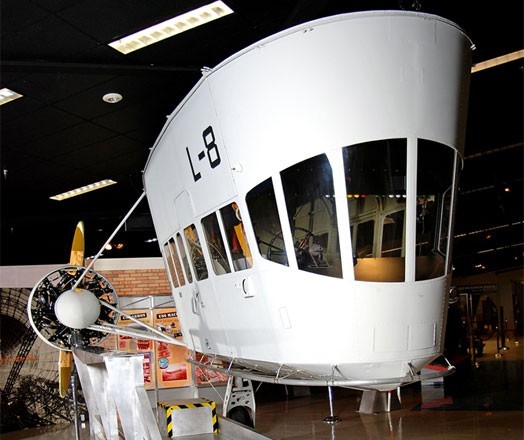
The refurbished gondola of the L-8 on display at the National Museum of Naval Aviation. Image via www.history.navy.mil.
*************************************************
Sources:
Mystery of the Ghost Blimp by John J. Geoghegan https://www.historynet.com/mystery-of-the-ghost-blimp.htm.
The Crew of the L- 8, https://unsolvedmysteries.fandom.com/wiki/The_Crew_of_the_L-8
The Bizarre Tale Of The World War II Ghost Blimp And Its Missing Crew by Gina Dimuro, https://allthatsinteresting.com/ghost-blimp
In 1942, a war blimp fell out of the sky onto Daly City. Its crew was never found by Katie Dowd and Andrew Chamings, https://www.sfgate.com/sfhistory/article/SF-Ghost-blimp-Daly-City-15739903.php
Ghost Blimp Mystery of WW2 – Crashed in San Francisco & Crew Was Never Found by Ruslan Budnik, https://www.warhistoryonline.com/instant-articles/mystical-disappearance-pilots.html.
#HushedUpHistory#featured articles#world war ii#WWII#airship#WorldWarIIhistory#wwii history#californiahistory#unsolvedmysteries#unsolved#mystery#weirdhistory#strangehistory#scaryhistory#forgottenhistory#horrorstory#scarystory#historyclass#historyisnotborning#creepyhistory#wheredidtheygo#historicmystery#historiesmysteries#truth is stranger than fiction#truestory#weirdstory#blimp#L8#ghostblimp
73 notes
·
View notes
Text
Ronnie Bell Following
Vought SBU-1 Corsair.
The Vought SBU-1 Corsair was a two-seat, all-metal biplane dive bomber built by Vought Aircraft Company of Dallas, Texas for the US Navy. Its design was based upon the F3U-1 two-seat fighter that was abandoned when the Navy decided not to build any more two-seat fighters.
The aircraft was equipped with a closed cockpit, had fixed landing gear, and was powered by a Pratt & Whitney R-1535 radial air-cooled engine as had the F3U-1, but also included a controllable pitch propeller and a new NACA cowl with adjustable cowling gills on the trailing edge of the cowl. The adjustable cowling gills permitted better control of cooling airflow over the engine.
The SBU-1 completed flight tests in 1934 and went into production under a contract awarded in January 1935. The Corsair was the first aircraft of its type, a scout bomber, to fly faster than 200 mph. The last SBU Corsairs were retired from active service in 1941, being reassigned as trainers.
The name "Corsair" was used several times by Vought's planes; the O2U/O3U, SBU, F4U, and the A-7 Corsair II.
Via Flickr
9 notes
·
View notes
Photo

On the prowl... world’s fastest Navy fighter.
#f8u#vought f-8 crusader#f-8 crusader#u.s. navy#u.s. military#fighter jets#naval aviators#vought aircraft company#chance vought#carrier aircraft#f-8h#crusader#vietnam war#vintage advertising#vintage illustration
4 notes
·
View notes
Text
USS TEXAS (BB-35): Aviation
While writing my TEXAS modification series, I found I needed to do a dedicated post on the different observation float planes shes had over her career.
These aircraft were used from scouting, to rescue and to spotting enemy positions and radioing back to ship for better accuracy.
She had 10 different models assigned to her.
1. Sopwith Camel (December 13, 1918 to June 19, 1919)
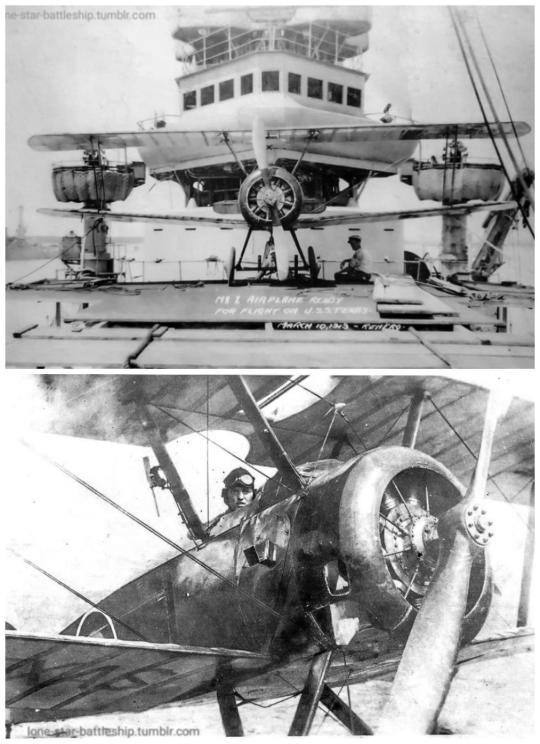
Note: three were brought back to the US from Europe for testing and 1 or 2 were tested and launched from her in the spring and summer of 1919.
2. Hanriot HD2 (July 14, 1919 to September 28, 1919)

3. Vought UO-1 (fall 1923 to July 3, 1928)

Note: this particular UO-1 was assigned to USS Texas before her modernization and came back after it was complete.
4. Loeing OL-6 (January 1, 1927 to June 27, 1928)
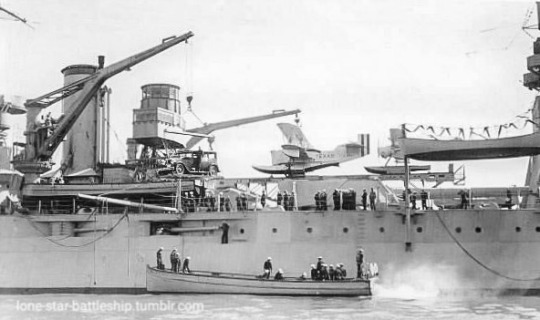
Note: The ship’s newspaper, the Texas Steer, referred to it as “the duck”. It did not have anything good to say and commented that it leaked oil badly.
5. Vought O2U-1 Corsair (June 28, 1928 to June 1930)

Note: Vought company apparently loved the name Corsair and reused it several times, including the famous F4U Corsair. It wasn't until after the F4U did they add a roman numeral to distinguish each model.
6. Vought O2U-3 Corsair (June 1930 to June 1931)
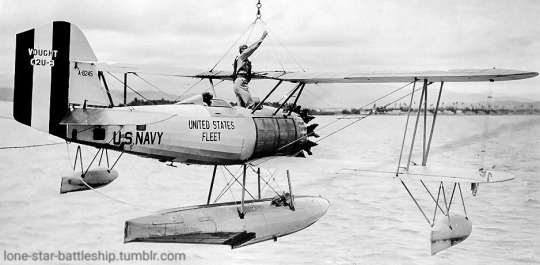
7. Vought O3U-1 Corsair (June 1931 to June 1936)
Note: this model is nearly indistinguishable from the previous and since Tumblr limits me to 10 pictures per post, I decided not to include a picture.
8. Vought O3U-3 Corsair (1934 to Summer 1937)

9. Curtiss SOC-3 Seagull (October 16, 1939 to April 29, 1941)
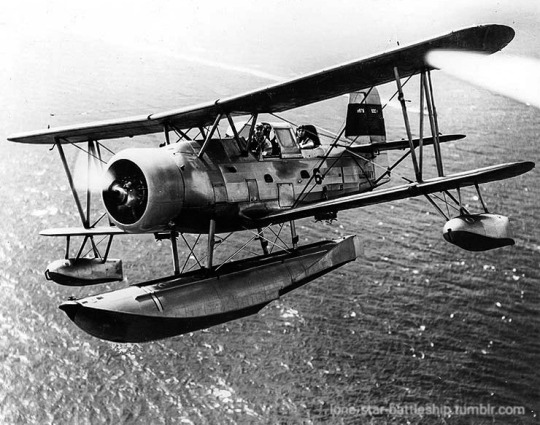
10. Vought OS2U Kingfisher (Summer 1941 to December 12, 1945 )
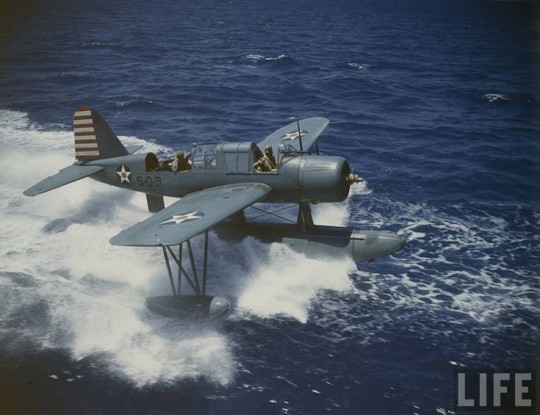
She carried complement of 2 or 3 of these aircrafts during WWII. During the Invasion of North Africa in November of 1942, one airplane sank and another bombed enemy tanks. After the invasion, Walter Chronkite flew off TEXAS in a kingfisher when the ship was within range of Norfolk. He was the first to report back on the event and launched his career.
During the invasion of Normandy, the airplanes and catapult were removed and the pilots were given Spitfires to fight German fighters and be spotters.
During the invasion of Okinawa, one sank during recovery due to damage from anti-aircraft fire and another strafed small Japanese boats.
To read more, read my post on it: link
Bonus: a drone (~January 1945 to ~August 1945)

These were brought onboard for AA target training and practice.
To see how they were launched, see my post here.
source, source
#USS Texas (BB-35)#USS Texas#Battleship Texas#new york class#dreadnought#battleship#Aviation#USS Texas History series#united states navy#us navy#usn#navy#my post
28 notes
·
View notes
Link
Download Episode 397!
NEW FUN COMICS 1, February 1935, was published on January 11, 1935. It contained 32 pages for the cover price of 10¢. Lloyd Jacquet was the editor. It was published by National Allied Publications, the company that would evolve into the DC Comics we know today.
FAMOUS FIRST EDITION: NEW FUN COMICS #1 was published on May 19, 2020 for the cover price of $19.99.
- (8:29) I review the book, JACKIE ORMES: THE FIRST AFRICAN AMERICAN WOMAN CARTOONIST by Nancy Goldstein, published by the University Of Michigan Press in 2019. This book was 226 pages long.
- (11:45) MY PULL LIST, where I review the comic books that carried the November 2020 cover date, which were released during the month of September, and I received from Discount Comic Book Service.
- (26:45) Before the reprint of NEW FUN COMICS 1, this FAMOUS FIRST EDITION had two introductions. The first was titled, THE START OF SOMETHING BIG, written by comic book historian Jerry Bails for a previously planned reprint of this issue that was eventually never published.
- (28:33) A SECOND INTRODUCTION was written by Roy Thomas, explaining why that first reprint never happened, and what the historical significance is of this issue.
- (30:11) JACK WOOD, subtitled PANCH VILLA Part I, a western adventure was written and drawn by Lyman Anderson, according to Mike's Amazing World Of DC Comics. The Grand Comic Book Database gives this feature the subtitle as, DON NAGLES - CATTLE RUSTLER Part I, written by Malcolm Wheeler-Nicholson and drawn by Lyman Anderson. Jack Wood rode into the sunset with his final appearance in ADVENTURE COMICS 42, September 1939.
- (33:27) The adventure strip SANDRA OF THE SECRET SERVICE in THE GAVONIA AFFAIR part I, was written and drawn by Charles Flanders, according to Mike's Amazing World Of DC Comics, while the Grand Comic Book Database credits Malcolm Wheeler-Nicholson as the writer and Charles Flanders as the artist. Sandra's final mission for the Secret Service would occur in MORE FUN COMICS 35, September 1935.
- (34:11) The comic strip OSWALD RABBIT, which was written and drawn by John Lindermeyer, appeared on the bottom of the page. It filled the gap at the bottom of the page below not only SANDRA OF THE SECRET SERVICE, but many of the early features in this issue. Oswald made his final appearance in MORE FUN COMICS 7, January 1936, but would make various appearances in various titles for other comic book publishers.
- (35:03) JIGGER AND GINGER, a teen humor strip, writer unknown, was drawn by Adolph Schus. They would make only one other appearance in NEW FUN COMICS 2, March 1935.
- (35:50) The adventure strip BARRY O'NEIL, in FANG GOW OF CHINA part I, according to Mike's Amazing World Of DC Comics, was written by Malcolm Wheeler-Nicholson and drawn by Lawrence Lariar. Barry's final adventure occurred in ADVENTURE COMICS 60, March 1941.
- (37:17) THE MAGIC CRYSTAL OF HISTORY, a kid adventure strip, was written and drawn by Adolphe Barreaux. Bobby and Binks would take their final historical adventure via the Magic Crystal in MORE FUN COMICS 50, December 1939.
- (38:45) The adventure strip WING BRADY: SOLDIER OF FORTUNE began with THE BEDOUINS part I. Mike's Amazing World Of DC Comics credits Henry Carl Kiefer (who signed his name as de Korosett, his wife's maiden name) as the writer and artist, while the Grand Comic Book Database lists Malcolm Wheeler-Nicholson as the writer and Kiefer as the artist. Brady's final adventure occurred in MORE FUN COMICS 52, February 1941.
- (40:19) Sir Walter Scott's IVANHOE was adapted to comic book form by Charles Flanders, according to Mike's Amazing World Of DC Comics, while the Grand Comic Book Database lists Malcolm Wheeler-Nicholson as the writer of this adaption and Flanders as the artists. This adaption of IVANHOE ended with MORE FUN COMICS 27, December 1937.
- (41:54) JUDGE PERKINS, a humor strip, was written and drawn by Bert Nelson Haig. The Judge would only have one more misadventure, in NEW FUN COMICS 2.
- (42:57) The science fiction adventure, DON DRAKE ON THE PLANET SARO, was written by Ken Fitch and drawn by Joseph Clemmens Gretter, who signed his art as Clem Gretter. Drake had his final adventure in MORE FUN COMICS 17, January 1937.
- (44:17) LOCO LUKE, a western humor strip, was written and drawn by Jack A. Warren. Loco Luke rode into the sunset after NEW FUN COMICS 4, May 1945.
- (46:41) SPOOK RANCH was a western mystery story written by Malcolm Wheeler-Nicholson, using the pseudonym Roger Furlong, with illustrations drawn by Charles Flanders. The story concluded in the next issue.
- (46:41) SCRUB HARDY was a sports humor strip drawn by Joe Archibald. Hardy's sports career was cut short, only appearing again in NEW FUN COMICS 2.
- (48:19) The sports adventure strip JACK ANDREWS ALL-AMERICAN BOY was written and drawn by Lyman Anderson. Andrews' sports career would only last through NEW FUN COMICS 6, October 1935.
- (51:04) BATHYSPHERE - A MARTIAN DREAM, writer unknown, was an article about Dr. Beebe, who descended 3,000 feet in a bathysphere, and the equipment on board.
- (51:59) SPORTS, an article written by Joe Archibald, was about the Toronto Maple Leafs and a brief history of the game of hockey.
- (52:59) ON THE RADIO: THE DIAL TWISTER, maybe written by Lloyd Jacquet, was an article asking readers to write the staff of NEW FUN COMICS and share their favorite radio shows, and the writer also shares some favorites.
- (54:27) IN THE MOVIES: TALK OF THE TALKIES, writer unknown, described some of the upcoming films in 1935, including one involving the comic book cowboy Jack Wood, a movie serial titled RUSTLERS OF RED GAP (IMDb lists the final title as RUSTLERS OF RED DOG).
- (55:24) MODEL AIRCRAFT, writer unknown, with illustrations drawn by Dick Loederer, was an article about how to make a model of the U.S. Navy plane Vought Corsair, one of the early planes that took off and landed on the first aircraft carriers.
- (56:49) HOW TO BUILD HENDRICK HUDSON'S "HALF MOON", an article written and drawn by Robert Weinstein, about a 17th Century sailing ship.
- (57:08) CAP'N ERIC, a sea adventure strip, was written and drawn by Robert Weinstein, who signed this feature Bob Weinstein.
- (58:33) BUCKSKIN JIM: THE TRAILBLAZER, a western adventure, was written and drawn by Eugene Koscik, who signed his work as "K". Buckskin Jim rode off into the western sunset after MORE FUN COMICS 18, February 1937.
- (1:01:28) The article POPULAR SCIENCE, writer unknown, had illustrations provided by Dick Loederer, who signed his work as "Loe". It covered three subjects, STREAMLINE TRAIN THAT TALKED, PUTTING THE SUN TO WORK, and A BIT OF MAGIC.
- (1:03:06) STAMPS AND COINS, writer unknown, also had illustrations drawn by Dick Loederer, who again signed his work as "Loe". This article was divided into two sections, BEGINNING A COLLECTION, about stamps, and ABOUT COINS.
- (1:03:50) The issue's final article was titled YOUNG HOMEMAKERS, writer unknown, also with illustrations provided by Dick "Loe" Loederer. This article provided advice about a well organized kitchen.
- (1:04:39) AFTER SCHOOL, a kid humor strip, was written and drawn by Tom McNamara. Lefty and Slim had their last humorous adventure in NEW FUN COMICS 6, October 1935.
- (1:05:43) CAVEMAN CAPERS, a prehistoric humor strip, was written and drawn by Dick Loederer. The fire went out for CAVEMAN CAPERS after NEW FUN COMICS 5, August 1935.
- (1:06:42) FUN FILMS: TAD AMONG THE PIRATES, was written and drawn by Adolphe Barreaux. This feature was unique among the others in this issue. It was a series of strips that you could cut horizontally and tape together into a paper film strip, viewed through a paper backdrop drawn at the top of the page. Tad's final adventure occurred in NEW FUN COMICS 3, April 1935.
- (1:07:20) BUBBY AND BEEVIL, a humor strip, was written and drawn by Dick Loederer. Bubby and Beevil's last misadventure was in NEW FUN COMICS 3, April 1935.
(1:07:41) The animal humor strip PELION AND OSSA was written and drawn by John Lindermeyer, who signed his work as Kevin Hay. Their last adventure was also in NEW FUN COMICS 3, April 1935.
- (1:08:35) This issue's final strip was the science fiction adventure 2023: SUPER POLICE, written by John Finch and drawn by Joseph Clemens Gretter, who signed his name as Clem Gretter. The Science Police investigated their last case in MORE FUN COMICS 14, October 1936.
- (1:10:11) After the reprinted issue, there were a few essays to round out this book. The first was titled, THE MAJOR WHO MADECOMICS, about Major Malcolm Wheeler-Nicholson, written by his Granddaughter, Nicky Wheeler-Nicholson. She provides a brief biography about her Grandfather, how his interests in life helped shape the features that were included in this first issue, and some of the talented comic book creators whose careers he helped influence.u
- (1:10:38) NEW FUN 1 - THE CONTRIBUTORS, brief biographies of most of the creators in this issue, also provided by Nicky Wheeler-Nicholson, with special thanks to David Saunders for his original research.
- (1:11:17) The book's final essay was titled, A TABLOID TRADITION CONTINUES, written by Editor Benjamin Le Clear, Manager of DC Comics Library Archives. He explains how and why this issues printed at tabloid size, and a brief history of the evolution of the size of comic books, and finally the origin of the FAMOUS FIRST EDITION series in the 1970's.
- Next episode we return to our journey through the Silver Age Adventures of Superman with: SUPERMAN FAMILY COMIC BOOKS COVER DATED MAY 1966: PART I: WORLD'S FINEST COMICS 157, PART II: SUPERMAN 186, PART III: SUPERMAN'S GIRL FRIEND LOIS LANE 65 & PART IV: ACTION COMICS 337 with ELSEWHERE IN DC COMICS' May or May/June 1966 titles.
The home for THE SUPERMAN FAN PODCAST is http://thesupermanfanpodcast.blogspot.com. Send e-mail to [email protected] can join the SUPERMAN FAN PODCASTGroup or Page on facebook, and follow the podcast on twitter @supermanpodcast. You can also keep track of the podcast on Tumblr, Medium, Flipboard, the Internet Archive, tunein, Stitcher, Amazon and Instagram.
SUPERMAN FAN PODCAST is a proud member of:
- The LEAGUE OF COMIC BOOK PODCASTERS and
- The COMICS PODCAST NETWORK.
The theme of this podcast is PLANS IN MOTION, composed by Kevin MacLeod, and part of the royalty free music library at http://incompetech.com. "Plans in Motion" Kevin MacLeod (incompetech.com) Licensed under Creative Commons: By Attribution 3.0 License http://creativecommons.org/licenses/by/3.0/
Superman and all related characters are trademark and copyright DC Comics. Any art shown on this podcast is for entertainment purposes only, and not for profit. I make no claims of ownership of these images, nor do I earn any money from this podcast.
If you are interested in my artwork, go to wayfarerercomics.wordpress.com. I am available for commissions, so click on the Art Commissions tab for more information. If interested, send an e-mail to [email protected].
Thanks for listening to the SUPERMAN FAN PODCAST and, as always, thanks to Jerry Siegel and Joe Shuster, creators of Superman!
And don't forget to take care of each other out there.
2 notes
·
View notes
Video
Goodyear FG-1D Corsair at the Museum of Flight, Seattle by fsll2 Via Flickr: From the Museum's website: The Chance Vought F4U Corsair (this example was built under license by the Goodyear Company) was the premier Navy and Marine fighter of World War II. The Corsair, along with the Grumman Hellcat, are credited with turning the tide of the Pacific air war by overwhelming the once-fearsome Japanese Zero fighter. Besides its role in air-to-air combat, Corsairs were used as fighter-bombers near the end of WWII and throughout the Korean War. The Corsair had an unusually long production run for a WWII-era aircraft with 12,571 examples, the last in 1952. Chance Vought designer Rex B. Beisel, a graduate of Seattle's Queen Ann High School and the University of Washington, designed the Corsair around the large Pratt & Whitney R-2800 "Double Wasp" 2,250-horsepower engine and massive propeller. Instead of building long, awkward landing gear needed for propeller clearance, Beisel's bent-wing design allowed for shorter, stronger gear for carrier landings. The unusual wing not only gave the Corsair its distinctive shape, but also reduced drag, allowing the "Bent Wing Bird" even greater speed. The Museum's Corsair was built in April 1945 and served aboard the USS Intrepid. After the war, it was transferred to the Naval Reserve, and eventually stationed at Naval Air Station, Sand Point, Seattle in 1950. That July, Commander Ralph Milleson made a water landing on Lake Washington following a non-fatal midair collision with another Corsair. The aircraft was recovered from the lake in 1983 and restored. This aircraft was restored and dedicated to the memory of Lt.(jg) Jerome Reese Schuchart, USNR, to serve as a tribute to all military aviators. Jerome died April 13, 1989 in the service of his country. This aircraft loan courtesy of the National Naval Aviation Museum at Pensacola, Florida.
14 notes
·
View notes
Text
X plane 11 liveries

#X plane 11 liveries simulator
#X plane 11 liveries download
By Aeroworx (Johan van Wyk and Fred Stegmann). 96 Airbus A350-941 China Airlines B-18918 Carbon Fiber - Airbus Livery ReignSUPREME 4 days. There is no intention to violate copyright or other stipulations placed by aircraft model designers.
#X plane 11 liveries download
This is a public beta version, PLEASE read the "Release Notes" attached to the download. 16 ENTRGA POR DOWNLOAD COMPATIVEL COM XPLANE 11 Version V1. Work is only for X-Plane 11 aircraft models. The Sperry is the primary autopilot, but for the more "modern" guys, a G530 is available as a pop-up. This aircraft features a fully 3D vintage virtual cockpit, with dozens of mouse click-able animations. Socials Networks Facebook Instagram Discord.
#X plane 11 liveries simulator
Shipping Board Emergency Fleet company is standardizing two sets. We work on sceneries and liveries for X-Plane 11, Prepar3D and Microsoft Flight Simulator 2020. Getting good photographs is no problem, the crews flying and maintaining these aircraft are also extremely helpful in providing us with documentation, advice, etc. The ground on July 11 for a new plant at The U. Recently released are HD and UHD options of X-Plane 11 Mesh scenery Buy add-ons for. As members of the South African Airways Museum Society, we have direct access to their C-47 and also a few other DC-3/C-47's. Initially, the Livery was created for AEROFLOT in the Yak-12 style. At the end of July, Aeroworx obtained the permission to port this aircraft to X-Plane. 690 ( 1 x 500 ) Naval Aircraft Factory 1, 120 ( 1 x 1,000 ) Vought - Sikorsky. This magnificent aircraft was originally designed by Manfred Jahn, Jan Visser and Team and is being flown by hundreds of happy users. D Netherlands 1, 265 ( 4 x 1,000 ) Consolidated - Vultee, s. Between 19 Douglas built a total of 10,654 of the type and over 80 years later there are still almost 1,000 in flying condition. The Douglas C47 is a twin-engined low wing transport aircraft, powered by Twin Wasp R1830-90C engines. X-Plane Handbook Traffic - ATC Flight School Ground - Airport. X-Plane 11 Aeroworx Douglas C-47 Dakota Beta 2.5.

0 notes
Text
Ronnie Bell Following
US Navy Vought F7U-3 Cutlass (129549) in 1955.
Vought F7U Cutlass was a United States Navy carrier-based jet fighter and fighter-bomber of the early Cold War era. It was a highly unusual, semi-tailless design, allegedly based on aerodynamic data and plans captured from the German Arado company at the end of World War II, though Vought designers denied any link to the German research at the time. The F7U was the last aircraft designed by Rex Beisel, who was responsible for the first fighter ever designed specifically for the U.S. Navy, the Curtiss TS-1 of 1922.
Regarded as a radical departure from traditional aircraft design, the Cutlass suffered from numerous technical and handling problems throughout its short service career. The type was responsible for the deaths of four test pilots and 21 other U.S. Navy pilots. Over one quarter of all Cutlasses built were destroyed in accidents. The poor safety record was largely the result of the advanced design built to apply new aerodynamic theories, insufficient thrust and unreliable engines.
Via Flickr
9 notes
·
View notes
Text

-A full-scale mockup of the A-12 Avenger II was built by General Dynamics. | Photo: General Dynamics/US Navy
Flightline: 48 - General Dynamics A-12 Avenger II
In 1983, the US Navy opened the Advanced Tactical Aircraft competition to develop a replacement for the A-6 Intruder. The new airplane would incorporate the latest in low-observable/stealth technology, and would be armed with precision guided munitions, possibly including nuclear weapons. Two teams provided concepts, McDonnell Douglas and General Dynamics advanced a triangularly shaped airplane with tandem seating, while the proposal from Northrop/Grumman/Vought was very much a miniaturized B-2 and featured side-by-side seating.

-Line drawings of the two ATA proposals, circa 1984. | Illustration: Tommy Thomason
The McDonnel Douglas/GD design was selected as the winner by default, as the Northrop/Grumman/Vought team did not submit a final proposal. The aircraft was designated the A-12, and christened the Avenger II in homage to the Grumman TBF Avenger. The first flight was expected by December of 1990. Navy orders were expected to be around 600 airframes, with the USMC ordering 238. The USAF was briefly interested in ordering 400 land-based derivatives to replace its F-111 Aardvarks, though they later dropped out

-CGI rendering of the A-12 showing various elevations as well as the folding wings. | Graphic: Anynobdy
The A-12, quickly nicknamed the “Flying Dorito” or just “Dorito”, would have been 37ft long, with a wingspan of 70ft and a folded width of 36ft. The airplane would have weighed 80,000lbs fully loaded, with two GE F412 engines providing a high subsonic speed.

-Line drawings of the A-12, with wings extended and folded, overlaid against the F-14 and A-6 | Illustration: U.S. Navy Naval Aviation News
Armaments were planned to be carried in an internal weapons bay, and would have included 5,160lbs of a mix of AIM-120 AMRAAMs, AGM-88 HARM anti-radiation missiles, and then-current USN/USMC guided and unguided bombs.

-An artist’s concept of the McDonnell Douglas A-12 Avenger II aircraft in flight. | Illustration: U.S. Navy All Hands magazine
McDonnell Douglas and GD soon encountered issues however, as the complicated radar system and difficulties fabricating the composite airframe led to mounting delays and increasing weight. A critical design review was successfully completed in October of 1990, and the first flight was rescheduled for 1992. At this time the Navy was still planning for 14 carriers to carry 20 A-12s each.

-An artist’s impression of the McDonnell Douglas/General Dynamics A-12 Avenger II aircraft. | Illustration: U.S. Navy Naval Aviation News
The issue came to a head in December 1990 when then-Secretary of Defence Richard Cheney called on the Navy to justify the A-12 and provide reasons why it should not be canceled. The response from the Navy and McDonnell Douglas/General Dynamics proved to not be persuasive, and the program was terminated on 7 January 1991.
“The A-12 I did terminate. It was not an easy decision to make because it’s an important requirement that we’re trying to fulfill. But no one could tell me how much the program was going to cost, even just through the full scale development phase, or when it would be available. And data that had been presented at one point a few months ago turned out to be invalid and inaccurate.”
-Secretary of Defense Dick Cheney, 1991.
The government accused both contractors of being in breach of contract, and demanded repayment of the $2 billion dollars spent on the A-12 by that point. Both companies strongly rejected the accusation, and began a series of lawsuits and counter-suits that lasted until 2014, with the successors of both companies being ordered to pay $1.35 billion, plus interest amounting to $1.45 billion.
Neither McDonnell Douglas nor General Dynamics aircraft division survived the debacle, with GD selling its Fort Worth aircraft division to Lockheed in 1993, and MD merging with Boeing in 1997.
The loss of the A-12 program resulted in the USN and USMC having to rely on older A-6 and A-7 aircraft longer than planned, with the latter retiring in 1991, and the former in 1997. Precision strike was then passed on to the F-14, which had since been modified with a LANTIRN pod, until the F/A-18E/F Super Hornet joined the fleet in 1999.
The A-12 Avenger II mockup, the only physical portion of the program to survive, was eventually unveiled in 1996, and in 2014 it was transferred to the Fort Worth Aviation Museum for restoration and eventual display.

-The A-12 mockup being moved via 18-wheeler.Photo: Fort Worth Aviation Museum (Fair Use)
#aircraft#aviation#avgeek#cold war#airplanes#airplane#cold war history#coldwar#aviation history#us navy#General Dynamics#McDonnell Douglas#a12 Avenger#avenger ii#stealth
88 notes
·
View notes


